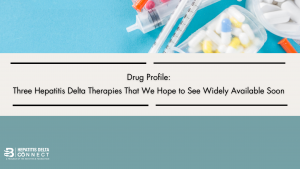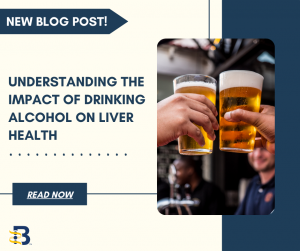
The full extent of hepatitis delta’s (HDV) global disease burden is still unknown and treatment options for HDV have been limited. However, there are three promising up-and-coming drugs to treat HDV patients. This blog post details the drugs’ current phase of development and testing, how well they work for patients in the real world, and their current path toward regulation and market availability.
Bulevirtide (Hepcludex)
Gilead Sciences Inc. has been seeking approval from the U.S. Food and Drug Administration (FDA) for bulevirtide, or Hepcludex, since 2021. In 2020, Gilead acquired MYR, a German pharmaceutical company that had developed the hepatitis delta virus (HDV) drug. At the time that it was acquired, Hepcludex had already been conditionally authorized for use in Germany, France, and Austria (MYR Pharmaceuticals, 2020). Gilead, which is based in California, in the U.S., hoped to accelerate the global launch of Hepcludex. Since then, however, Hepcludex remains in regulatory limbo. In October 2022, the FDA announced the rejection of Hepcludex, citing concerns around the manufacturing and delivery of the drug. Gilead responded by stating that they plan to resubmit Hepcludex for approval as soon as possible (Dunleavy, 2022). Six months after the FDA rejection, the Committee for Medicinal Products for Human Use, which is the European Medicines Agency’s (EMA’s) committee responsible for conveying its opinions on medicinal products to the public, stated that it recommends Hepcludex for full marketing authorization in Europe. Since its conditional approval, a Phase 3 trial (which utilized data from patients in Germany, Italy, Russia, Sweden, and the U.S.) has shown it to be safe and effective for HDV patients. If the European Commission fully approves Hepcludex, it will be the only authorized HDV treatment available in Europe (Dunleavey, 2023).
Lonafarnib
At the end of 2022, Eiger Biopharmaceuticals announced that lonafarnib reached an important milestone in its phase 3 trial.
The trial includes two regimens in patients with chronic HDV:
- 1. Lonafarnib boosted with ritonavir, a protease inhibitor, which interferes with the ability of certain enzymes to break down proteins, often used in combination with other therapies for antiviral activity (this is an all-oral therapy), and
- 2. Lonafarnib in combination peginterferon alfa, an antiviral and immunosuppressive, which either completely or partially suppresses the immune system, often used to treat hepatitis B (HBV) and hepatitis C (HCV) patients (this is a combination therapy).
Both treatment arms showed statistical significance over the placebo arm of the trial. The placebo arm is used as a control in drug testing and has no therapeutic effect on patients. The results showed three noteworthy findings: 1. After 48 weeks (about 11 months) of treatment with the all-oral regimen, a small number of patients may achieve reduced viral load and improved liver function. 2. Combining lonafarnib and ritonavir with peginterferon alfa showed the potential to almost double the effectiveness of the drugs. 3. Combination treatment may lead to significant liver tissue improvement. Researchers found that most adverse symptoms related to treatment were either mild or moderate in severity, with gastrointestinal issues being the most frequent (Eiger Biopharmaceuticals, 2022).
Peginterferon Lambda
In June 2023, the results of a phase 2 trial looking at the safety and efficacy of peginterferon lambda (also an Eiger Biopharmaceuticals product) in HDV patients were published. Previously, peginterferon lambda showed a good tolerability profile (or the degree to which patients can tolerate negative treatment symptoms) in patients with HBV and HCV when compared to peginterferon alfa. In this trial, patients received 120-mcg or 180-mcg peginterferon lambda injections over 48 weeks, followed by 24 weeks of post-treatment follow-up. Researchers found that 180-mcg injections were more effective in HDV patients compared to the 120-mcg injections group. Results showed that with 48 weeks of 180 mcg treatment, patients showed a significant reduction in HDV RNA, the molecules responsible for perpetuating the virus in HDV patients. 36% of patients’ HDV RNA levels were undetectable. Some of the adverse symptoms patients experienced were flu-like symptoms and elevated transaminase levels, or enzymes that are related to a fatty liver. Most adverse symptoms were mild or moderate in nature and were resolved without additional treatment (Etzion et al, 2023).
These three drug therapies show promise for HDV patients. Hepcludex is well on its way to becoming fully authorized in Europe after its three-year conditional approval and recent Phase 3 trial results. Lonafarnib’s phase 3 trial results are encouraging and Eiger, its manufacturer, plans to begin meeting with regulatory agencies, such as FDA and EMA, to discuss regulatory submissions (Eiger Biopharmaceuticals, 2022). Peginterferon lambda has shown a higher tolerability in patients with a lower adverse event rate than peginterferon alfa, which has been modestly used for the treatment of HDV over the past several decades (Etzion et al, 2023). Peginterferon lambda still has a ways to go before regulatory discussions, considering that results have just been published from its Phase 2 trial. Typically, in Phase 2 trials, researchers seek to learn whether the treatment they are studying is effective in fighting the disease. Phase 3 will test whether peginterferon lambda is more effective than already available, standard treatments. Hopefully, these three drugs continue to show positive results for HDV patients and will become widely available over the next few years. There are a number of other HDV drugs currently in development, but these are still in the early stages of clinical trial testing. You can stay up to date on the latest developments of these drugs by checking out the Hepatitis Delta Connect Drug Watch page.
Dunleavy, K. (2022, October 28). Gilead hits surprise FDA rejection for hepatitis D drug already authorized in Europe for 2 Years. Fierce Pharma. https://www.fiercepharma.com/pharma/gilead-gets-fda-rejection-hepatitis-d-drug-already-authorized-europe-two-years
Dunleavy, K. (2023, May 5). After FDA rejection, Gilead’s Hepcludex looks set for full EU NOD. Fierce Pharma. https://www.fiercepharma.com/pharma/gileads-hdv-drug-hepcludex-gets-thumbs-chmp
Eiger announces both lonafarnib-based treatments in pivotal phase 3 D-LIVR trial in Hepatitis Delta virus (HDV) achieved statistical significance against Placebo in composite primary endpoint. Eiger BioPharmaceuticals. (n.d.). https://ir.eigerbio.com/news-releases/news-release-details/eiger-announces-both-lonafarnib-based-treatments-pivotal-phase-3
Etzion, O., Hamid, S., Lurie, Y., Gane, E. J., Yardeni, D., Duehren, S., Bader, N., Nevo-Shor, A., Channa, S. M., Cotler, S. J., Mawani, M., Parkash, O., Dahari, H., Choong, I., & Glenn, J. S. (2023). Treatment of chronic hepatitis D with peginterferon lambda-the phase 2 LIMT-1 clinical trial. Hepatology (Baltimore, Md.), 77(6), 2093–2103. https://doi.org/10.1097/HEP.0000000000000309
MYR Pharmaceuticals. (2020, September 17). Myr Pharmaceuticals launches HEPCLUDEX® in Germany, France and Austria. PR Newswire: press release distribution, targeting, monitoring and marketing. https://www.prnewswire.com/news-releases/myr-pharmaceuticals-launches-hepcludex-in-germany-france-and-austria-301133006.html





 diagnosed with hepatitis B, or maybe you are spending this year alone because you are scared to begin a relationship. This year, instead of focusing on others, take Valentine’s Day to love yourself – and your liver!
diagnosed with hepatitis B, or maybe you are spending this year alone because you are scared to begin a relationship. This year, instead of focusing on others, take Valentine’s Day to love yourself – and your liver!  produced by a mold that grows on crops like corn, peanuts, and tree nuts. Aflatoxins are more common in warm, humid parts of the world, such as African countries and areas with tropical climates. Before eating any grains and nuts, check for any signs of mold. If the food appears to be moldy, do not consume it. The World Health Organization also
produced by a mold that grows on crops like corn, peanuts, and tree nuts. Aflatoxins are more common in warm, humid parts of the world, such as African countries and areas with tropical climates. Before eating any grains and nuts, check for any signs of mold. If the food appears to be moldy, do not consume it. The World Health Organization also 
 Both issues can impair the liver’s ability to function and filter out toxins that enter the body. They can also increase a person’s risk of developing liver cancer. Recently,
Both issues can impair the liver’s ability to function and filter out toxins that enter the body. They can also increase a person’s risk of developing liver cancer. Recently, 

